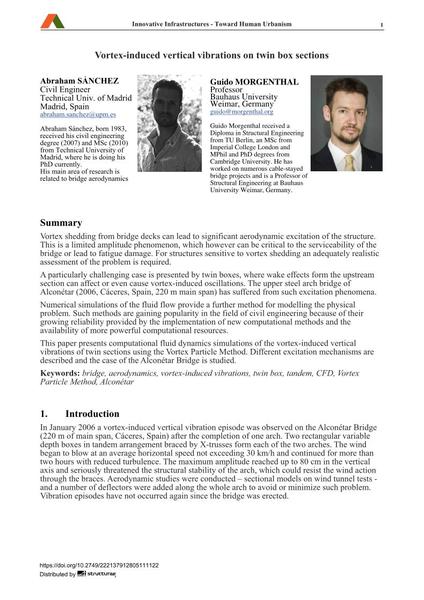Vortex-induced vertical vibrations on twin box sections

|
|
|||||||||||
Bibliografische Angaben
| Autor(en): |
Abraham Sánchez
Guido Morgenthal |
||||
|---|---|---|---|---|---|
| Medium: | Tagungsbeitrag | ||||
| Sprache(n): | Englisch | ||||
| Tagung: | 18th IABSE Congress: Innovative Infrastructures – Towards Human Urbanism, Seoul, Korea, 19-21 September 2012 | ||||
| Veröffentlicht in: | IABSE Congress Seoul 2012 | ||||
|
|||||
| Seite(n): | 787-794 | ||||
| Anzahl der Seiten (im PDF): | 8 | ||||
| DOI: | 10.2749/222137912805111122 | ||||
| Abstrakt: |
Vortex shedding from bridge decks can lead to significant aerodynamic excitation of the structure. This is a limited amplitude phenomenon, which however can be critical to the serviceability of the bridge or lead to fatigue damage. For structures sensitive to vortex shedding an adequately realistic assessment of the problem is required. A particularly challenging case is presented by twin boxes, where wake effects form the upstream section can affect or even cause vortex-induced oscillations. The upper steel arch bridge of Alconétar (2006, Cáceres, Spain, 220 m main span) has suffered from such excitation phenomena. Numerical simulations of the fluid flow provide a further method for modelling the physical problem. Such methods are gaining popularity in the field of civil engineering because of their growing reliability provided by the implementation of new computational methods and the availability of more powerful computational resources. This paper presents computational fluid dynamics simulations of the vortex-induced vertical vibrations of twin sections using the Vortex Particle Method. Different excitation mechanisms are described and the case of the Alconétar Bridge is studied. |
||||
| Stichwörter: |
Brücke wirbelerregte Querschwingungen Aerodynamik CFD
|
||||
